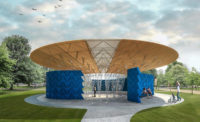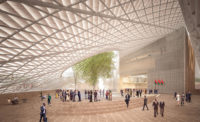The goal of the project is to provide a place where local residents and international visitors can work together to develop imaginative building methods using indigenous materials.
“The place has been packed with people, coming to help and see the progress,” said Abdoul Galbané, a cell phone dealer from Ivory Coast who was in Gando visiting family. The tall young man had extended his stay just so he could be a part of the construction process. “I've never seen such a unique design,” he said. “Everyone has been talking about Gando and its nice buildings.”
I was in this dusty, remote village in mid-February, at the peak of the dry season, to see the work of Diébédo Francis Kéré, a charismatic architect whose remarkable personal story and well-designed, sustainable, and low-tech buildings have earned him widespread acclaim. On this particular day, the community was helping construct his latest undertaking: the Atelier, a training center and dormitory being built in cooperation with the Academy of Architecture in Mendrisio, Switzerland, where Kéré is a professor. His goal is to create a venue where both residents and international visitors can develop imaginative building methods using indigenous materials.
The building itself exemplifies the Atelier's mission. Inspired by the round mud huts ubiquitous in the region, the center will consist of three connected circular volumes. Totaling 6,000 square feet and rising nearly 22 feet, it will be the tallest clay structure in the area. “It's like building a skyscraper in New York!” exclaimed the high-energy Kéré, who tends to move quickly and speak emphatically. “It will be the first time in Burkina Faso's history to have a traditional compound of this size. I want my people to learn that we can create bigger spaces using the resources we have available: clay and the power of the community.”
Gando, with its subsistence economy and lack of plumbing and electricity, is not a place where aspirations are easily achieved. Kéré, now in his 40s, grew up here. As the eldest son of the chief, he was sent off to attend primary school in a neighboring town at the age of 7. He went on to win a scholarship to study carpentry in Germany and later enrolled in an architecture program at the Technical University of Berlin. In 2001, while still a student, he completed his first project: a simple yet elegant primary school in Gando made with local materials and labor. An exemplary fusion of modern and vernacular design, the project won an Aga Khan Award in 2004 and put Kéré (and his village) on the world map.
Today, the tireless architect spends much of the year in his native country while maintaining a small firm in Berlin, enabling him to take on the occasional project in Europe. He just won first place in a competition to reimagine military barracks in Mannheim, Germany, for instance, and in 2013 he completed a permanent exhibition for the International Red Cross and Red Crescent Museum in Geneva. Kéré has also held teaching positions at several universities (Harvard's GSD among them), and he frequently speaks at schools and design events around the globe. During his rousing lectures, it's not uncommon for the exuberant architect to jump off the stage or pound on the floor to illustrate a point. His talks typically draw standing ovations.
All of these undertakings help support Kéré's work back in Burkina Faso, where he has continued to build schools, health clinics, and other civic-minded projects since finishing his architecture studies in 2004. Most recently, he has completed a medical center in Léo, a town of 30,000 near the border with Ghana. His projects are largely funded through a nonprofit foundation he established, Building Blocks for Gando. Constantly on the hunt to raise money, Kéré relies on donors and sponsors from overseas, as Burkina Faso is one of the poorest countries in the world. Its gross national income per capita is $670 (compared to $52,340 in the United States), and the average life expectancy is 55 years, according to the World Bank. “You hear of people living on less than a $1 a day. This is where they do it,” Kéré said as we passed through a lively market just outside of Gando, where balls of fried dough were being sold for a penny apiece.
Through architecture, Kéré is providing jobs, educational opportunities, and models for future development in a place where progress seems elusive. “We have nothing. We rely on Diébédo to help,” says Zémane Gampoko, a village elder who leads the Gando Women's Association. Kéré's transformative power is clearly evident in the primary school he completed over a decade ago. He has since added six houses for teachers and a second classroom building, and has almost finished a library and a separate complex for secondary students. Each school day, hundreds of girls and boys arrive at the campus on foot or by bicycle—and, sometimes, by donkey.
“Everyone loves it because we can have kids coming from neighboring villages, which is good,” says Sosthene Sawadogo, a 39-year-old teacher. “The more kids we have, the better—the more who will be successful later.” Already, three graduates have enrolled in college—a triumph, given that fewer than 20 percent of Burkinabe children even attend secondary school, a percentage even lower in rural areas.
As I toured the school with Kéré, instructors and administrators eagerly approached him, and youngsters often bowed in his presence. The buildings were well cared for; even the brightly painted window shutters were not chipped or faded. “Seeing all of these kids being happy and coming out of all the classrooms, it makes me very proud,” Kéré told me as we took a rare break, sitting in the school's shaded courtyard. “I've had a big opportunity that other people don't have: the chance to gain knowledge.” Thanks to his indomitable spirit and pioneering work, Kéré is now ensuring that inhabitants in Gando and beyond are afforded the same precious opportunity.
































Post a comment to this article
Report Abusive Comment